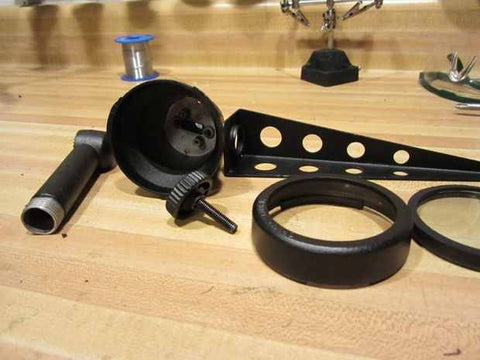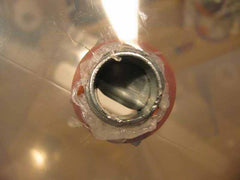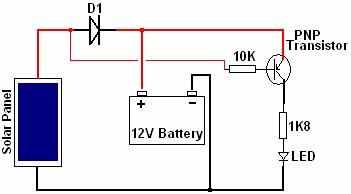
High Power Solar Lighting System

Cost: $75 - 100
Time: 2 - 3 Hours
I bought all the electronics off of eBay on the cheap. The hardware parts I bought from a local hardware store. The total cost of this project was in the range of $75 - 100. Not overly expensive, but much cheaper than any store bought high powered solar lighting system. Plus a whole lot more powerful. I also bought a more expensive driver than I needed in case I wanted extra functions, you could easly shave $10 off the project by getting a cheaper one.
The majority of your time will be spent trying to figure out how to run wires into and out of things. The amount of real "making" work is rather small.
STEP 1: Gather Materials
To be honest, we're pretty much just hacking a cheap lighting system into a solar lighting system. Most of the parts we will need come preassembled. We're mostly just wiring things up. The nice part about that is the fact that we only have to do a little soldering.
Parts:
Cheap Lighting System (With 2 or more metal "heads")
Heavy Duty Outdoors Wire
High Powered LEDs (1 Watt or 3 Watt depending on your needs)
High Powered LED Driver
Heat Sinks
18V or better Solar Panel
12V Solar Charge Controller
12V Battery
Wire
Plastic Container
Washers
Cable Clamp
Terminal Strip
Dark Detecting Circuit:
PNP Transistor (I used a TIP42)
A Prototyping Board
10,000 Ohm Resistor
1N4001 Diode
Tools:
Soldering Iron
Helping Hand
Screw Drivers
Silicon Calk
Wire Stripper and Cutter








STEP 2: High Powered LEDS
High powered LEDs are not like your regular LEDs. They use a lot of current and put out a lot of heat. They are, however, quite cheap. I bought mine on eBay for a few dollars. I went with 3 Watt LEDs because... well... I like the power. Most people would be happy with some 1 Watt LEDs.
One thing to keep in mind is that these LEDs need a "driver." This is a circuit designed to regulate current so you don't blow out your LED. Plus you can use any LED color type without having to switch out resistors. Quite handy. When buying a LED Driver make sure you're getting one with the same power rating as the LED you want to use. My driver can handle up to 10 Watts, which is perfect for running two 3 watt LEDs off of 12V. (Or so says the instruction PDF file.)
In the picture above I'm using the driver on the left. It can handle 10 Watts of output. The one on the right you can use to power a single 1 Watt LED. As you can probably guess the one on the left is more expensive. I choose to get this more expensive driver for it's added features, and you can easily make things cheaper by going with a more "standard" driver.
(Plus if you're really feeling adventurous, you can hook up a micro controller to the LED Driver to do some crazy effects. Oh yes. Arduino power your LED lighting system. Which I might do. Just because I can. Have it pulse in and out or do strobes at a certain time...).

STEP 3: Take Apart the Lighting System
This lighting system was bought on clearance, so I had no issues gutting it.
First cut the wires going into the housing.
Then remove the various electronics on the inside. In this case it's just the connector that would hook up the regular light bulb.
Just cut and pull.





STEP 4: Thread the Wire
Now take your new outdoors wire and thread it back along the same path.
I had to use some needle nosed pliers to help pull it through at one point. Not too tough to do, but slightly awkward.
Make sure to leave a good amount of wire sticking out the top so we can solder.
(Make sure you thread it in the EXACT same way as the original wire. While this may not always be possible, it is the most simple solution. Otherwise drill a hole in the side and later seal it up with some calk.)

STEP 5: Solder Your LED
Strip the ends of the wire.
Use a helping hand, or some other holder, to grip the LED.
Now solder one wire onto a + tab and one onto a - tab.
After I soldered the LED I also put a heat sink on the bottom of the LED. These guys can get hot, and since we're in a mostly enclosed space I don't want to take any risks.


STEP 6: Reassemble
Well now you're going to want to pull the extra wire back through the housing. Take this time to situate your LED.
(I honestly just wedged it in there. No need for extra adhesive or parts. If you do try and use something, make sure it's heat resistant.)
Reassemble your little lighting unit.
Ta da! You have a high powered LED inside of a classy metal outside lighting structure!
Now go do this one or two more times.
I made two heads for this project, but I'll eventually make a third as my driver can handle it.



STEP 7: Create the Enclosure
As this is going to be outside I wanted to make a nice safe enclosure to handle Wisconsin weather.
I took a plain plastic tub and modified it a bit using a cable clamp. More or less a big screw in system that latches onto wires to hold them in place. I got this from a local hardware store, and they had several types.
To make the hole in the side of the tub I chose to use an old soldering iron and melt a hole. Using a drill will work for some people if their enclosure can handle it. I have bad luck with drilling plastic and I don't want any cracks.
Once the hole was the right size for the clamp I twisted it into place. I also added in a rubber washer to help protect against water. Once everything was in place, I used some silicon caulk to further water protect it all. (Yes, when you run wires through there will still be open space. Try running the wires through a couple of rubber washer, and use those to seal up the holes. That and more caulk if you want things to be super permanent.)
If you're worried about water coming in the top, get some rubber and line the inside of the lid. A cheap and easy O-Ring also works. You could also add a line of caulk as well for similar protection. If you want to make things very easy for yourself, find a food container that already has an O-Ring built in, though they can get expensive at the size we're using.





STEP 8: Wire Up Everything Else
From here on out, we're just screwing wires into place. The hard work is over.
I cut some wire and attached it to a terminal connector for use with my battery. You may wish to do the same, or just use some alligator clips.
I then connected the Positive and Negative tabs on my battery to the B+ and B- terminals on the Charge Controller. As my charge controller uses screw clamps, this was easy.
Then I took some more wire and hooked it up to the L+ and L- on the charge controller. These are the "Load" terminals that supply power to whatever it is you're trying to run.
Those then connected to the V+ and Ground (Negative) screw terminals on my LED Driver.
Told you the hard stuff was done.






STEP 9: Wiring Up the LEDs
To wire in the LEDs we're going to do the exact same type of connecting, but using a terminal strip.
Take the Positive wire from one of your LEDs and hook it into the LED Driver + Out Clamp. (If you don't know which is positive and which is negative, grab a multimeter and do a quick test.)
The Negative wire from that LED needs to go into one of the Terminal Strip holes.
Take the Positive wire off the other LED, and put it in the same terminal strip hole.
The Negative wire you have left over goes into the LED Driver completing the circuit.
if you didn't catch what we're doing, we're hooking things up in a Series. Positive to Negative, Positive to Negative. If we wanted to we could add more LEDs into the mix doing the same pattern. My driver can do 10 watts, which means if I provide a 24V power input I could easily control ten 1 Watt LEDs. Though I'm just going to do 2 or 3 of my 3 Watt LEDs.




STEP 10: Test It Out
Well at this point you're either being blinded by LEDs or you messed up somewhere. Hopefully you're being blinded.

STEP 11: Put Everything Into the Box
Well now that you know how everything hooks together, it's time to wire up the box. (Which means you're going to have to unscrew all your wires. But don't complain, it's an easy task!)
Run all your wires into the box. The two LEDs and the Solar Panel.
Now reconnect everything together. Does it work?
(Hook the Solar Panel into the Solar Charger Controller by screwing the wires into the S+ and S- clamps.)


STEP 12: Enjoy!
Well that's it. You should be getting a whole lot of light coming at you. Stick it outside and enjoy. You now have a great lighting system that looks classy and will provide a lot of light.
You can use this same design with any color of LED. I enjoy the cool refreshing choice of "white" light.
You could also modify this design and use it for lights inside your home or on your deck. Same idea, but add a switch into the mix.
If you're an overachiever you may wish to go to my "final final" step and make yourself a dark detecting circuit. It only takes a couple of minutes and makes you seem all the more awesome to the neighbors.




STEP 13: Buy Hey Now..
So many of you are probably wondering why I've not talked about darkness detecting. Meaning the fact that this system is just always "on", which is a waste of power and very very annoying.
To do this all you need is a strong PNP transistor, a 10K Ohm resistor, and a diode.
Check out the circuit diagram above to see what I mean.
What we're doing is using the transistor as a "gateway". When the transistor is getting power from the solar cell (meaning day time) the "gate" is closed. At night time when there is no power coming from the solar panel, the "gate" opens and power goes to the LEDs.
More or less we're using a system similar to how regular small garden lights work, and all for the cost of a PNP transistor and a resistor.
The key is finding a strong enough transistor. A standard 2N3904 will NOT work. You'll nee something that can handle higher voltages and a higher current. As my solar panel is 21V at 0.6amp I'm using a transistor with a bigger kick.
Another option would be to use a Microcontroller (such as an Arduino) to control the LED Driver. The driver I have has a PWM port. It would be easy to wire an Arduino into the setup to act as the darkness detector. Though to be honest that is a bit of an overkill for this project. You could also then power the Arduino via the 12V battery, and in my case I could use the built in USB ports on the charge controller. (I may in the future, but thats a different guide all together.)

STEP 14: Make a Dark Detecting Circuit
Parts:
1N4001 Diode (or something similar)
TIP42 Transistor (or any similar PNP transistor)
10,000Ohm Resistor
A Prototyping Board
Wire
(If you have an extra heat sink, use it.)
Tools:
Soldering Iron
Wire Cutter
All we're doing is soldering on the transistor, resistor, and 3 wires to the prototyping board. The diode we use in conjunction with the solar panel later on.
***Before you do ANYTHING you should locate information about what each leg of your transistor does what. You have a Base, Emitter, and a Collector. Know which one is which. Usually it's on the packaging, otherwise google it.***
Put the transistor in the middle of the board and solder it into place.
Find the Base leg. Put the resistor next to it, and solder the resistor into place. Now connect one leg of the resistor to the Base leg.
Now get your wire. We want to connect one wire to the free end of the resistor, to the Collector leg, and to the Emitter leg.
I also took one of my extra heat sinks and put it on the back of the transistor. While it probably isn't necessary, I might as well.





STEP 15: Other Transistor Things
It's important that you label which leg is which. Seriously. If you don't, you'll end up like my FIRST attempt at this circuit. The one where my transistor sparked and split in two.

STEP 16: How to Wire It Into Your System
The last thing to do is break out the screwdriver and wire it into the system. Along with the diode.
Remove the Positive wires of both the solar panel and the LED driver from the Charge Controller. (We're completely getting rid of the positive wire going between the Controller and the Driver and replacing it with this circuit.)
Find the Positive wire coming off your solar panel. Hook it up to the positive leg of your diode. Then put the Negative leg of the diode (it's the one with the black or silver bar on it) into the Positive input of your charge controller.
Take the Base wire from the Dark Detecting Circuit (it's the one with the resistor if you did things correctly) and attach it to the diode at the same point where you attached the solar cell's Positive wire. Or in other words, BEFORE the diode.
Next, take the wire coming off the Emitter leg and put it into the Positive Load spot on your Controller.
Lastly take the Collector wire and put it into the Positive power in clamp of the Driver.
That's it. Turn the solar panel face down and see if the LEDs turn on. Mine did. You can change how "sensitive" this circuit is by changing the value of the resistor in the circuit.

Here is a PDF with more pictures on how to make this High Powered LED Solar Lighting System: High-Powered-LED-Solar-Lighting-System.pdf
